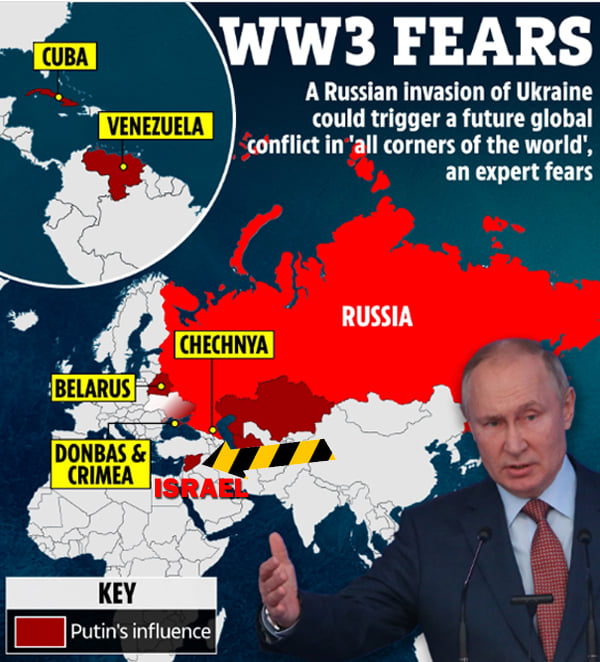Using Crimea and Splitting Turkey in Russia’s Strategy Against Israel

Russia’s Strategic Interest in Crimea: A Geopolitical and Prophetic Analysis
The annexation of Crimea by Russia in 2014 has been widely interpreted as a strategic move to secure naval dominance in the Black Sea and strengthen its geopolitical leverage against NATO and Ukraine. However, an alternative perspective emerges when analyzed through the lens of biblical prophecy and long-term military strategy. The drying up of the Euphrates and Tigris rivers, a phenomenon recorded in contemporary hydrological studies, aligns with prophetic interpretations that suggest a future military incursion from the north into the Middle East (Revelation 16:12). Russia’s occupation of Crimea provides it with the essential infrastructure to deploy land-based forces through Ukraine, positioning itself advantageously for a southward advance into the Levant.
Recent satellite imagery and military reports indicate that Russian forces have been expanding their logistic networks southward, ostensibly preparing for extended operational capacity beyond Ukraine. This movement aligns with Ezekiel 38, which speaks of a great northern power mobilizing toward Israel. The control of Crimea facilitates the use of land corridors, including the riverbeds of the drying Euphrates and Tigris, as viable routes for ground troop movements toward the Middle East. The historical precedent of dried riverbeds being used for military campaigns, such as those in ancient Mesopotamian conflicts, reinforces the plausibility of such a strategy.
The Implications of Splitting Turkey
Turkey’s geostrategic location has long made it a contested territory between global powers. Russia’s engagement with Turkey, often vacillating between diplomacy and military tension, suggests a broader plan to divide the nation. Russia has historically sought access to warm-water ports, and controlling parts of Turkey would provide a direct route into the Mediterranean, essential for projecting power into the Middle East. Biblical prophecies, such as Daniel 11:40-45, describe a northern king sweeping through the Middle East, which scholars interpret as a reference to an eschatological conflict involving major world powers.
Military analysts have noted that Turkey’s internal divisions—ranging from Kurdish separatist movements to ideological rifts between secularists and Islamists—could be exacerbated by external intervention. If Russia were to support separatist elements or engage in a direct military confrontation with Ankara, it could effectively partition Turkey, utilizing the eastern and southeastern regions as forward operating bases for an eventual military campaign against Israel. This aligns with longstanding Russian ambitions to expand its influence over the Bosporus and Dardanelles straits, a critical chokepoint for naval power projection.
Russia’s Long-Term Strategy Against Israel
Prophetic interpretations of Ezekiel 38-39, often referred to as the War of Gog and Magog, suggest an eventual coalition of northern powers targeting Israel. Russia’s military alliances with Iran and Syria, its arms sales to Hezbollah, and its growing presence in the Mediterranean point toward a strategic encirclement of Israel. Should Russia establish a stronghold in a divided Turkey, it would gain a crucial launching pad for an invasion into the Levant, a scenario eerily resembling biblical eschatological predictions.
Furthermore, Russia’s growing economic and military ties with Middle Eastern nations indicate an effort to consolidate power in the region. If Turkey were split, Russia could fortify a southern front, allowing for coordinated military action with its allies. The prophetic significance of these developments cannot be understated, as they align with scriptural warnings of a great northern coalition advancing against Israel in the end times.
Conclusion
While conventional geopolitical analysis frames Russia’s actions as strategic posturing within a multipolar world order, a prophetic interpretation suggests a deeper significance. The annexation of Crimea, the potential partitioning of Turkey, and the alignment with Middle Eastern allies all point toward a larger eschatological confrontation. As the Euphrates and Tigris rivers continue to dry, the pathways for military movement envisioned in ancient prophecy seem increasingly plausible. Whether viewed through the lens of strategic military doctrine or biblical foresight, Russia’s actions indicate a long-term vision that extends far beyond Ukraine and deep into the heart of the Middle East.

Toward a Pentecostal Strategy for the City
Toward a Pentecostal Strategy for the City
One of the questions that seems to come up in this course discussion is how to change the world around us with a more positive and effective approach toward using the Gospel of Salvation. In this particular module, the difficulty addressed is ethnocentricity. The particularity of our search then arrives at the more detailed question, how can we change the culture (respectively subcultures) of our church congregations? This is a drastic move from a closed circle toward an outreach community that many congregations are unable to accomplish. How do we then empower such congregations to be transformed into cultural reach-outs to a single ethnos or multiple ethnic groups?
Problem
The problem in the first quarter of the 21st century has been incongruity of our church strategy with the times we live in and the mindset they occupy. We’ve been preparing the church for the multicultural battle, all and while we should have been equipping the saints how to rebuild the walls since the battle has been lost.
We’ve been equipping leaders for the ministry while the church ship has been sinking only to end up with well trained captains of a sunken fleet. And in a doomed attempt to reconcile the reality of the ministry with their training, they have turned to wave walkers who briefly surface for breaths of fresh air during Sunday worship only to return to the deep blue walk of their daily ministry never finding their lost piece of eight.
For the battle was lost long ago before the present generation of ministers ever came to existence. They know not the battle. They’ve only seen the ruins that were left within the broken walls of the church. And they have been struggling to reconcile the incomputable of what church eldership has been teaching them to battle against with the Nehemiah calling for restoration, which God has placed upon them. For the answer has never been in building a New Jerusalem for a fresh start, but restoring the old Jerusalem and its former glory to a new state that reclaims our history and heritage.
Context
Recent analysis of migrant churches in the United States reveals that the predominant majority of them are located in cities which have a high influxation and concentration of immigrants. Such localities are called “gateway cities”. Immigrants typically enter the United States through one of these cities and settle there. These areas contain over half of the foreign-born population in the United States as follows:
- New York, NY – Foreign born population 18.7%
- Los Angeles, CA – Foreign born population 27.1%
- Houston, TX – Foreign born population 12.3%
- Washington, DC – Foreign born population 8.6%
- Miami, FL – Foreign born population 33.6%
- Chicago, IL – Foreign born population 11.1%
- San Francisco, CA – Foreign born population 20.0%
Strategy
Asking the right questions is important, but the answers cannot be generic for all ethnic groups or cultural settings. There is a strong need to be flexible and observe changes in culture, but not to change the message of the Gospel or compromise our witness. Several common things are noted in any cultural setting where our ministry is involved:
First and foremost, people of all cultures prefer to be personal with a purpose, rather than being project driven. No one longs to be part of someone else’s project. Yet, our very existence demands personal purpose, which could serve as a great cultural catalyst in a church ministry.
Secondly, cross cultural ministry is not done merely on relationships, but on being real in the relationships. The greatest halt of ministry work is when people realize the relationship with the church has not been a real one, but merely a part of a program or a paradigm.
Finally, our cross cultural model for ministry should not be just salvation oriented, but soul oriented. There is a great difference between writing down the number of saved every Sunday and actually caring for the eternal well-being of the saved souls. In fact, this is so fundamentally determinative that it should be the goal in mind of every new church plant.









